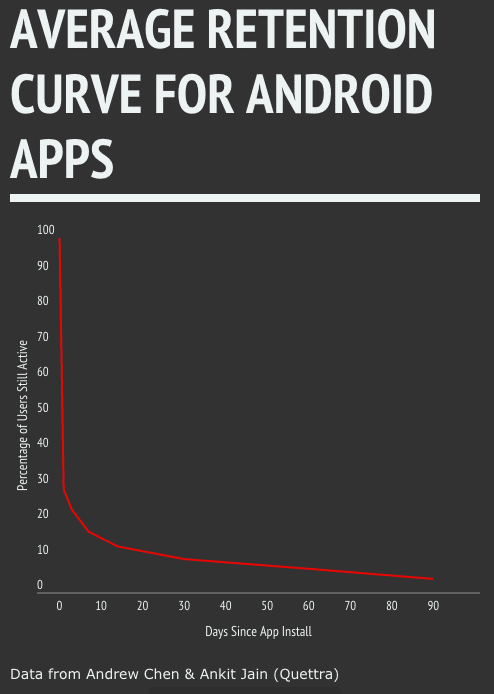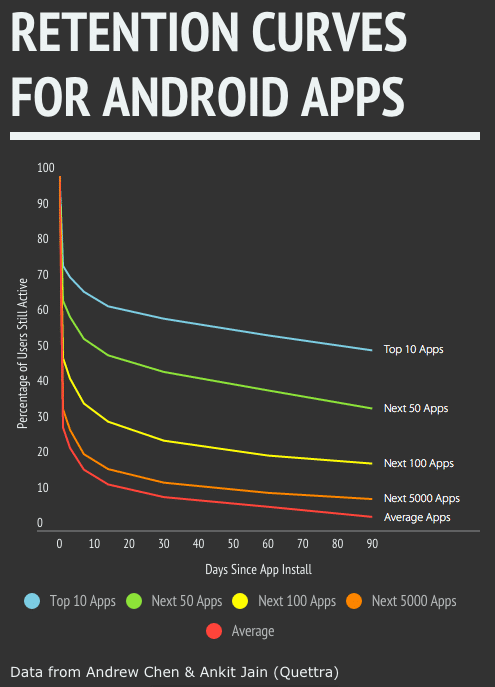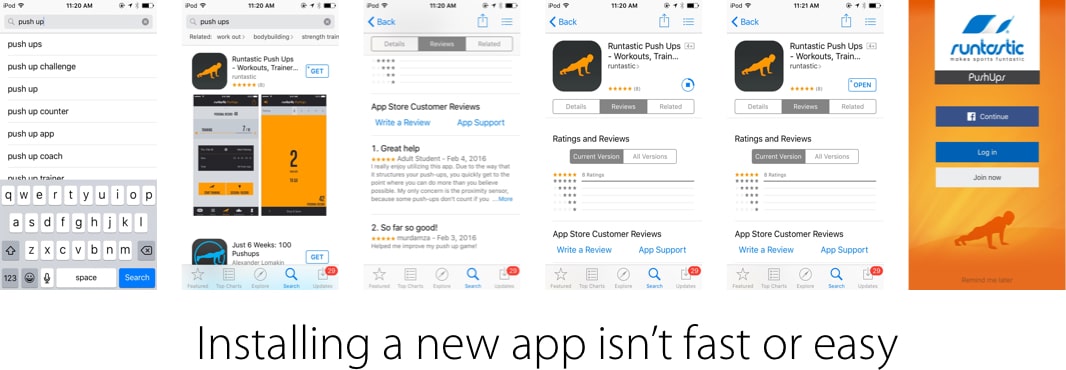7 Reasons Why Mobile Onboarding Is Your App’s 80/20
The Pareto Principle.
It says that 80% of the effects come from 20% of the causes. Simple right?
If you’re playing tennis, that 20% is probably footwork to make sure you’re in the perfect position to make a shot. When it comes to learning Japanese, that 20% is the most commonly used words such as the Kyouiku Kanji.
When it comes to growing your mobile app, that 20% is all about activating your mobile users.
So what is mobile onboarding? And why is it so vital for mobile growth?
Onboarding is the process of demonstrating the value of your product so that users come back.

Specifically, onboarding is the bridge between a download and activation. Once you’ve got users in your app, onboarding is how you demonstrate value and get them to return. So why is it the 20% that we should focus on?
1) 71% of the average app’s users drop off after just 1 day
Frustrating isn’t it? You spent all that time and effort trying to acquire users in the first place, only to lose a substantial majority in just the first day. After 30 days, you’ve lost 90%.
Within 90 days, you’ve lost 96%.

What every mobile team quickly learns is that building a great product and marketing it just aren’t enough to grow and sustain a mobile app. The app storesare overcrowded and mobile users are dropping off like flies just moments after install. Apps have to clearly demonstrate how invaluable they’ll be in users’ lives.
“The best way to bend the retention curve is to target the first few days of usage, and in particular the first visit. That way, users set up themselves up for success.” – Andrew Chen, Supply Growth @ Uber.
So what do the top apps do that separates them from the rest of the pack? They onboard their users. And the effects are tremendous.

Looking at the retention curves for top 10 apps, you’ll see that their day 1 retention is more than double the amount of the average app. Onboarding users well conveys a strong sense of value to the user that sets them up to return.
2) Onboarding Affects the Highest volume segment of users
When resources are limited, we want to focus on what’s going to get us the best results. As users move through your funnel from download to open to registration, they start to drop off with each successive step or barrier.

Since onboarding is at the top of your funnel, what you do in the early stages is going to affect the flow of users into later stages of your app. That means more users to engage, more that will retain, and more that will share or evangelize your app. With more users, you’ll be able to do a lot more with them, whether that’s focus on re-engaging them, having them convert, or whatever else your goals are.
3) Retaining a user is cheaper than acquiring new ones.
As we all know, acquisition costs on mobile are very high due to a broken distribution and discovery system. Keep in mind that it’s time spent on both sides: users and mobile teams. The teams have to spend lots of time and money to acquire a user through various channels. Users on the other hand, have to spend the time and effort to search, read reviews, input their password, and wait for a ~30 second download.

Acquisition costs are higher than those of retaining a user. Instead of spending most of your time on finding new acquisition channels or hacks, spend more making the most of the downloads you already have.
4) Churn is a better indicator of a great product than downloads
“I would argue that the single most telling metric for a great product is how many of them become dedicated, repeat users.” – Andrew Chen. When a user is onboarded correctly, you’re setting them up for long term success and retention. Now that they know what they can do with your app, they’ll be able to unlock it’s full potential and use your product to the best of its abilities.
5) If they don’t get past onboarding, they’ll never see your product (or share it)
“If you don’t nail onboarding, your developers may as well have been drinking beers instead of building those features that no one saw.” -Nancy Hua
While you may have spent all this time and effort building out amazing features for your dedicated users, those that drop off after just 1 day of use are unlikely to ever learn of their existence. Onboarding can help by pointing first time users to these awesome features and set them up for success.
6) Every New User Is…New
While not all of your users will see the amazing features you’ve built, every single new user will encounter the onboarding experience. What’s incredibly powerful is that you have a chance to test out new flows, changes, or tweaks without affecting your current users.
This means that you can test on even a small fraction of your new users and watch how their behavior differs from those who have not gone through your new onboarding experience. At the same time, your dedicated users won’t even notice a difference.
7) Onboarding Is Your First Impression
Onboarding the process through which you introduce an app to first time users and demonstrate its value. It’s your first impression, so you’d better make it amazing. Otherwise, you can kiss any chance of actually growing your app goodbye.

Spending your time improving onboarding is the most effective use of your time and efforts to ensure you have more users in your app to work with. This gives you a greater opportunity to engage them, retain them, and leverage their viral potential to drive even more app downloads.
Thanks for
reading!
More articles you might be interested in:
Best Practices for Refining Mobile Onboarding Flows
If you’re not retaining your users, all other effort is a waste of time and money. – Nancy Hua Click To Tweet By now, you know that onboarding is the most important element of mobile growth. You know that it...
Read MorePersonalizing Mobile User Onboarding
Feel like going to the Giants game at the last minute? Gametime is an app that let’s do just that and buy last minute tickets with just two taps on your phone. It avoids the hassle of printing or picking...
Read MoreWhy Vevo Got Rid of Onboarding Tutorial Screens
How We Optimized Our Native Mobile Login Flow By Corinne Almirol (Sr. Product Manager, Vevo) and Jon Li (Sr. Product Director, Vevo) So you want more registrations. You want users to log in so that you can start a relationship...
Read More